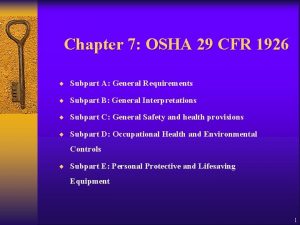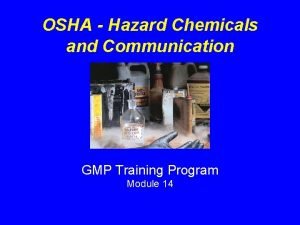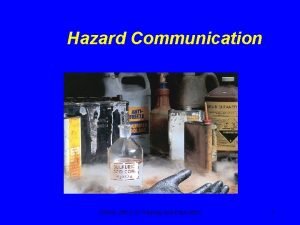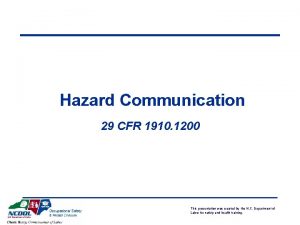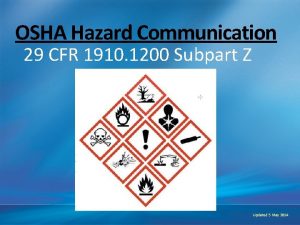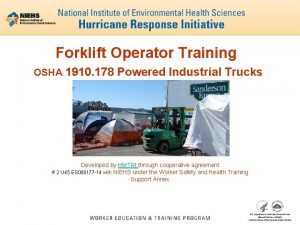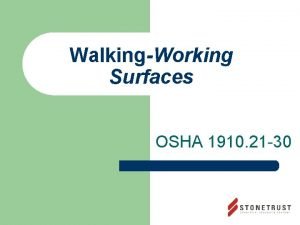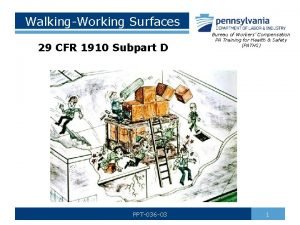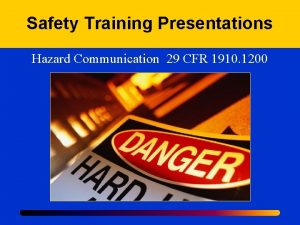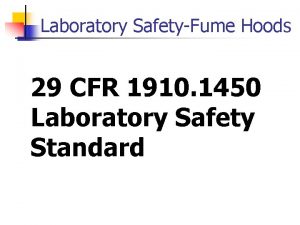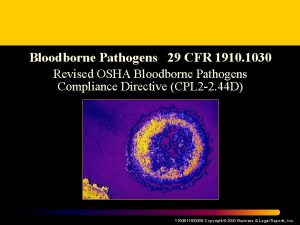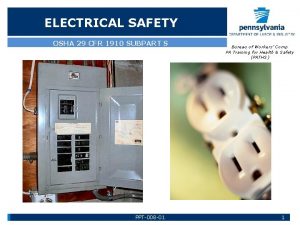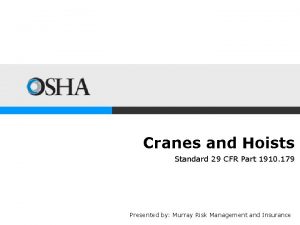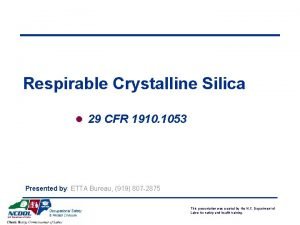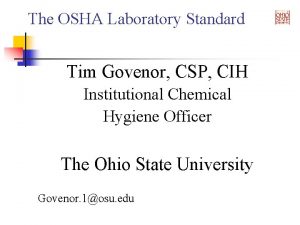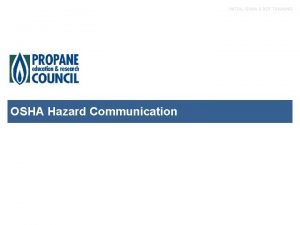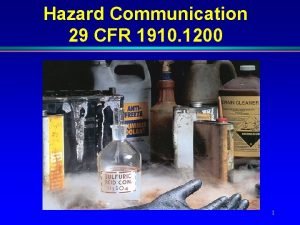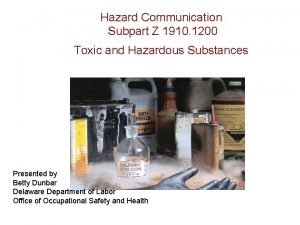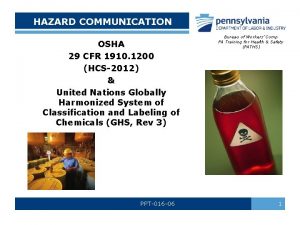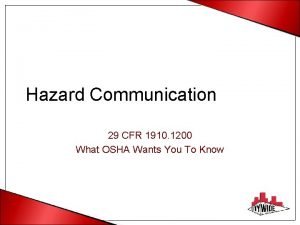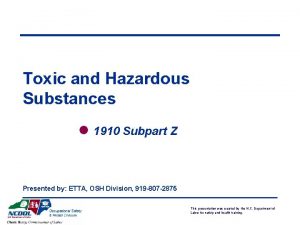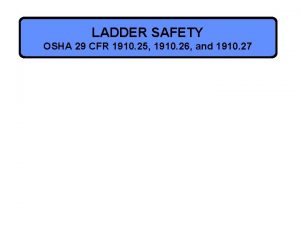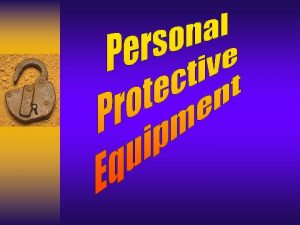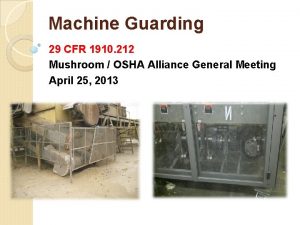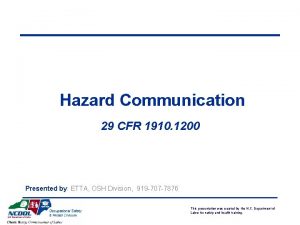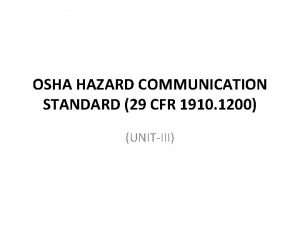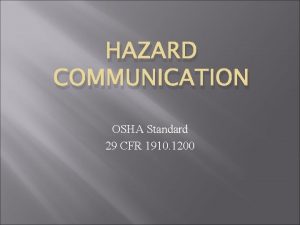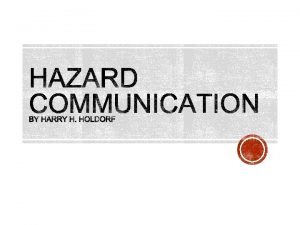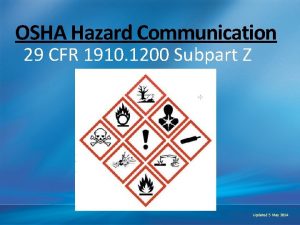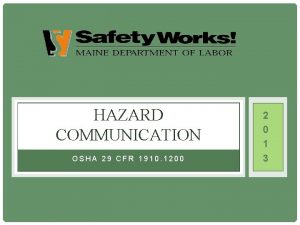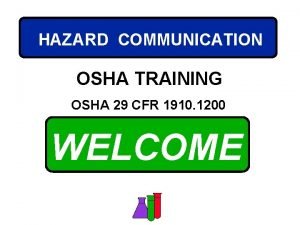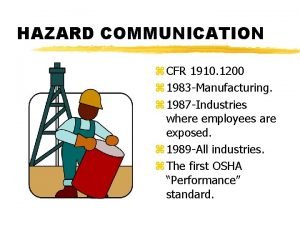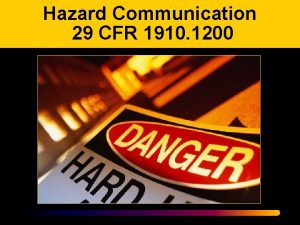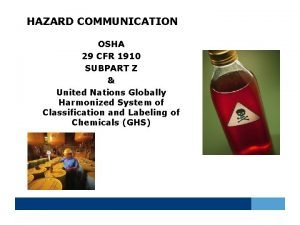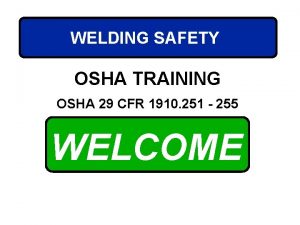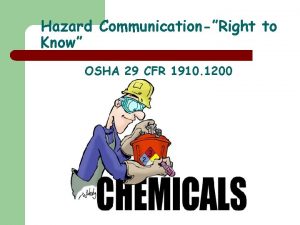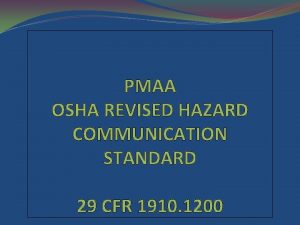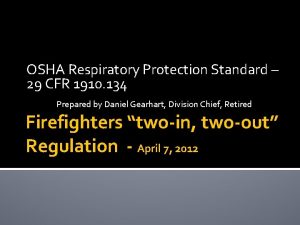HAZARD COMMUNICATION STANDARD OSHA 29 CFR 1910 1200
































- Slides: 32

HAZARD COMMUNICATION STANDARD OSHA 29 CFR 1910. 1200

HAZARD COMMUNICATION STANDARD • First adopted in 1983. Its purpose is to ensure chemical safety in the workplace. In order to do so, information about the identities and hazards of the chemical must be available and understandable to workers. • The Haz. Com standard (29 CFR 1910. 1200) was last revised in March 2012 to improve the quality and consistency of hazard information. It’s now aligned with the United Nation’s Globally Harmonized System of Classification and Labeling of Chemicals (GHS).

Z AZARD OMMUNICATION RITTEN ROGRAM . 1200(e)(1) 1 831 O . 212(a)(1) 1 481 Z HAZARD COMMUNICATION – INFORMATION AND TRAINING. 1200(h)(1) 1 442 N . 147(c)(4)(i). 178(l)(1)(i) I J LOCKOUT/TAGOUT – DEVELOPED PROCEDURES . 134(e)(1) 643 POWERED INDUSTRIAL TRUCKS – COMPETENCY 615 TRAINING RESPIRATORS – MEDICAL EVALUATIONS 614 O MACHINE GUARDS – POINT OF OPERATIONS. 212(a)(3)(ii) 614 I . 134(c)(1) K RESPIRATORS – EMPLOYER ESTABLISHING A WRITTEN RESPIRATOR. 151(c) Z 29 CFR 1910 SUBPARTS MACHINE GUARDS – GENERAL . 1200(g)(8) 499 PROGRAM EYE &BODY FLUSHING FACILITIES 494 HAZARDOUS COMMUNICATION – MAINTAIN COPIES OF 463 SDS’S Overall 1910 MFC MOST FREQUENTLY CITED SERIOUS 3 VIOLATIONS IN GENERAL INDUSTRY 2016 H C –W P

4 1200(e)(1) 1831 INFORMATION AND TRAINING 1200(h)(1) 1442 SDSS READILY ACCESSIBLE 1200(g)(8) 463 SDSS FOR EACH CHEMICAL 1200(g)(1) 384 HAZARD COMMUNICATION – DETAILED TRAINING 1200(h)(3)(iv) 335 SUBPART Z WRITTEN PROGRAM

OSHA’s GHS Approach (Globally Harmonized System) • Terminology better defined – Hazard classification (reversed) • Consistent SDS format • Labels have more specific requirements – 3 required elements when being shipped or received – Use of signal words • DANGER (more severe hazards) • WARNING (less severe hazards, caution still required)

Think of a tree, any kind?

Seven major elements in the GHS-aligned Hazard Communication Standard

Employer Responsibility: works

WRITTEN PROGRAM REQUIREMENTS: • Develop, implement and maintain • Lists of chemicals present • Availability of SDSs • Labeling of containers • Training, training (not required annually)

HAZARD COMMUNICATION STANDARD The Hazard Communication Standard covers both physical hazards (such as flammability or the potential for explosions) and health hazards (including both acute and chronic effects). By making information available to employers and employees about these hazards and recommended precautions for safe chemical use, illnesses and injuries caused by chemicals can be reduced.

Understanding the Numbers… for Flammability OSHA GHS Nomenclature NFPA 4 = Severe 3 = Serious 2 = Moderate 1 = Slight 0 = Minimal Flammability Criteria Cat 1 = Severe Hazard Cat 2 = Serious Hazard Cat 3 = Moderate Hazard Cat 4 = Slight Hazard GHS Category NFPA Rating FP <73 F, BP <100 F 1 or 2 4 FP <73, BP >100 F FP>73, BP<100 F 2 or 3 3 FP>100 F, <200 F 3 or 4 2 FP>200 F None 1 OSHA now considers flammable to be at a flashpoint at or below 199. 4°F

PHYSICAL HAZARDS Physical hazard means there is scientifically valid evidence that the chemical has the potential for one of the following hazardous effects: • • • Explosion Flammability Corrosive to metal Gas under pressure Organic peroxide • Oxidizer • Pyrophoric • Unstable (selfreactive) • Water-reactive

HEALTH HAZARDS A chemical is a health hazard if exposure can cause illness or other health problems. The following is a brief description of the major types of health hazards. • Corrosives - cause tissue damage and burns on contact with the • • • skin and eyes. Irritants - cause intense redness or swelling of the skin or eyes on contact, but with no permanent tissue damage. Sensitizers - cause an allergic skin or respiratory reaction. Acutely Toxic Materials - cause an adverse effect, even at very low doses. Carcinogens - may cause cancer. Teratogens - may cause birth defects. Organ Specific Hazards - may cause damage to specific organ systems, such as the blood, liver, lungs, or reproductive system.

ROUTES OF EXPOSURE To become harmful, a chemical must first enter or come in contact with your body (called "exposure"). For example, depending on the chemical and the manner in which it is handled, it may enter through different routes: • your lungs if you breath in fumes, mists or dust (inhalation) • your skin if liquid or dust touches or spills on you (dermal) • your mouth if you eat after handling chemicals, or if you accidentally swallow a chemical (ingestion)

EXAMPLE-DHMO • Death due to accidental inhalation, even in small quantities • Major component of acid rain • Leads to corrosion and oxidation of many metals • Can contaminate electrical systems • When mixed with a number of hazardous chemicals it can give off poisonous compounds

CHEMICAL LABELING Your first line of defense in protecting yourself against hazardous chemicals is knowledge of the chemical itself. All chemical containers in your workplace must have a proper label, which identifies the chemical and gives some information about its hazards.

TYPES OF LABELS: • • • GHS shipping labels HCS workplace labels NFPA 704 labels HMIS labels DOT shipping labels, placarding, and markings

WHAT'S ON A LABEL? All chemical manufacturers are required to label their products properly. Labels on all chemical containers leaving the workplace must supply the following information: • Product identifier: Must match SDS • Signal word: Danger or Warning • Hazard Statement: describes the nature of the hazard of a chemical. For example, ‘may produce an allergic reaction’ or ‘may form explosive peroxides’. • Precautionary Statement: describes the recommended measures that should be taken to minimize or prevent harmful effect resulting from exposure to the chemical or improper storage or handling. • Pictogram: graphic symbols that convey the health, physical and environmental hazard of the chemical. • Contact Information: name, address and telephone number of the chemical manufacturer, importer or other responsible party.

CHEMICAL LABELING The pictograms consist of a red square frame set at a point with a black hazard symbol on a white background. Each pictogram represents the health, physical or environmental hazard of the chemical. It's very common to see more than one pictogram for a chemical.

CONTAINER LABELING IN THE WORKPLACE Within the workplace, the hazard warning on chemical labels can be any type of message, picture or symbol that provides information on the hazards of the chemical(s) and the target organs affected. However, they must not conflict with the hazard warnings or pictograms provided under the OSHA Haz. Com standard. Labels must be: ü legible ü in the local language(s) ü prominently displayed

CONTAINER LABELING IN THE WORKPLACE National Fire Protection Association (NFPA) ratings are not intended to address normal occupational exposures, chronic hazards or carcinogens. Each colored diamond represents a different class of hazard. The hazard classes found on NFPA labels include: • Health (Blue) • Flammability (Red) • Reactivity (Yellow) • Special Hazards (White) Each hazard class uses a different color and a rating scale from 0 - 4. The higher the number on the rating scale, the more dangerous the substance. NOTE: the NFPA numbering scheme is opposite of what is used to classify hazards in the OSHA Haz. Com standard.

CONTAINER LABELING IN THE WORKPLACE HMIS which stands for Hazardous Materials Identification System. Originally developed by the National Paint & Coatings Association (NPCA), now known as the American Coatings Association In addition to the hazard warnings, personal protective equipment information is supplied to give employees information needed to protect themselves from hazardous materials they might encounter on the job. HMIS and NFPA are similar, but not identical. HMIS attempts to convey health warning information to employees, while NFPA is meant primarily for fire fighters and other emergency responders.

ONE LABELING EXCEPTION • Portable containers are exempt from the labeling requirements of HAZCOM when: • Portable container for immediate use and the container is completely emptied as a result of the transfer

SAFETY DATA SHEETS (SDS) Information Found On SDSs Safety Data Sheets provide detailed information about a specific hazardous material. It contains a 16 -section format.

16 SECTION SDS

16 SECTION SDS

DETECTING HAZARDOUS CHEMICALS There are three major ways to detect the presence or release of a hazardous chemical in the workplace: 1. Observing (primarily using your sense of sight or smell); 2. Using monitoring devices; and 3. Recognizing signs or symptoms of overexposure. Many chemicals can be detected by their appearance - liquid, powder or solid and their color. Chemical odor can also be very distinctive (such as chlorine) and may provide early warning of a release.


DETECTING HAZARDOUS CHEMICALS Chemical monitoring instruments are the safest and most reliable way of detecting a hazard chemical in the workplace. The type of instruments used varies with the chemical and the situation. • Area monitoring systems with local alarms (H 2 S example) • Portable instruments (gas monitors O 2, LEL, CO) • Use of gas detector tubes is another way to get a quick measurement in a specific area

PERSONAL PROTECTIVE EQUIPMENT Personal Protective Equipment (PPE) may be needed to protect yourself from chemical hazards. Refer to the label or the SDS to determine the appropriate type of PPE to wear. Examples of PPE include: • Gloves • Goggles • Face shields • Splash aprons • Respirators Wearing the appropriate PPE can prevent injury.

SAFE WORK PRACTICES Safe work practices ensure that chemicals are used correctly and safely. Some basic safe work practices are: • Keep the work area clean and orderly. • Follow standard operating procedures to the letter. Taking short cuts can greatly increase your risk. • Use the necessary safety equipment, including the PPE documented on the SDS. • Carefully label every container with the identity of its contents and appropriate hazard warnings. WHAT LABELS DO YOU REQUIRE AT YOUR FACILITY? • Proper chemical storage and ventilation can reduce hazard potential.

COMPANY RESPONSIBILITY Knowing how to train employees to work safely with chemicals that pose a hazard is an important activity. Ø Make sure that all chemical containers are properly labeled and employees understand the hazard warnings. Ø Current Safety Data Sheets for the chemicals in your work area easily available. Your employees have a right to know, but everyone has a responsibility to use their knowledge and skills to work safely.
 Osha 1910 1200
Osha 1910 1200 29 cfr 1910 hazard communication
29 cfr 1910 hazard communication Osha 1926 subpart c
Osha 1926 subpart c Osha hazard and ghs training regulation cfr 1910
Osha hazard and ghs training regulation cfr 1910 Osha cfr 1910 is the standard for______.
Osha cfr 1910 is the standard for______. 29cfr1910.1200
29cfr1910.1200 29 cfr 1910 section 1200
29 cfr 1910 section 1200 29 cfr 1910 powered industrial trucks
29 cfr 1910 powered industrial trucks 29 cfr 1910 osha 178
29 cfr 1910 osha 178 Osha platform requirements 1910
Osha platform requirements 1910 1910 subpart d
1910 subpart d Ppt-036
Ppt-036 29 cfr 1910 osha 178
29 cfr 1910 osha 178 29 cfr 1910 osha 178
29 cfr 1910 osha 178 29 cfr 1910 powered industrial trucks
29 cfr 1910 powered industrial trucks 29 cfr 1910 osha 178
29 cfr 1910 osha 178 Bloodborne pathogens standard 29 cfr 1910
Bloodborne pathogens standard 29 cfr 1910 Osha welding requirements
Osha welding requirements 29 cfr 1910
29 cfr 1910 Osha 1910 crane standard
Osha 1910 crane standard Osha silica standard 1910
Osha silica standard 1910 Osha laboratory standard 1910
Osha laboratory standard 1910 Osha hazard communication inital training
Osha hazard communication inital training 1910-1200
1910-1200 Ghs oxidizer pictogram
Ghs oxidizer pictogram 1910-1200
1910-1200 1910-1200
1910-1200 29 cfr 1910 subpart z
29 cfr 1910 subpart z Cfr 29 1910
Cfr 29 1910 29 cfr 1910 ppe
29 cfr 1910 ppe Osha 1910 machine guarding
Osha 1910 machine guarding 29 cfr1910.1200
29 cfr1910.1200 Osha 1910 forklift
Osha 1910 forklift


